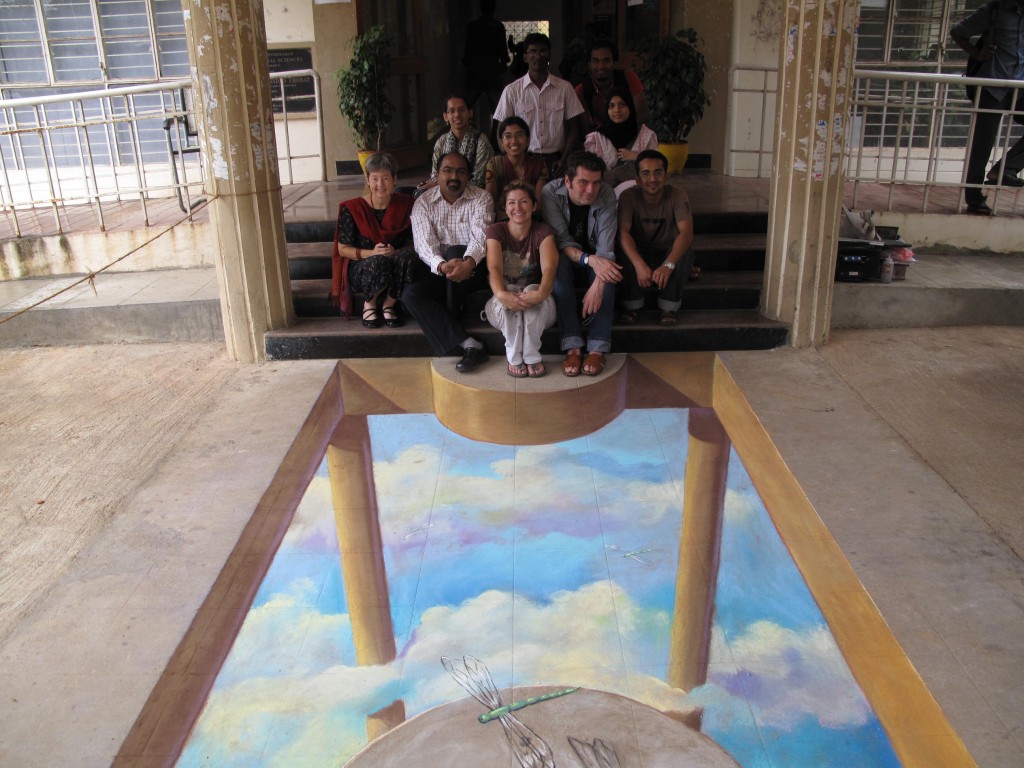
New Delhi
As some of you may know, I’ve recently returned from a rather exhilarating and adventurous trip to India where I participated at Antaragni Festival, IIT Kanpur as a guest featured artist. As part two of my India blog entries, this article focuses on the second phase of my trip, which was a 3D street painting workshop tour of prominent art colleges and universities throughout the country, sponsored generously by the American Center through the US Consulate in New Delhi.
Having worked with the US Consulate office in Mumbai last year in a similar capacity, I was invited by Aruna Dasgupta and her team to develop and demonstrate a 3D street painting workshop for local high school, college level and professional artists in New Delhi at the Habitat Center. The workshop was held over 3 days with morning and afternoon sessions which provided students with the opportunity to learn how to make street paintings and to delve into the mechanics behind basic 3D techniques.
What a wonderful first date for the tour. New Delhi is a rich city bursting with international flavor – right up my alley – and a population that proved to be open, generous, cosmopolitan and engaging. I knew that many accomplished artists lived and worked here and I was eager to interact with some of them. The American Center had set up a workshop location at The Habitat Center, a beautiful multi-use facility in the heart of New Delhi – they generously provided working areas for the students to create their masterpieces, as well as a spot in their amphitheater where I would create a larger 3D image with local professional artist volunteers. Each day a new group of 30 or 40 students arrived for participation, allowing for approximately 6 or 8 paintings per day. Most of the students had never seen street painting prior to the workshop so they were pretty excited to discover that, yes, it was o.k. to make chalk murals on the pavement there!
In setting up the workshops I had prepared a variety of images for the students to work from, suitable for first timers and those with a bit more ambition. The students were divided into groups of 6 to 10 each, with one painting assigned to each group. After 3 days of working we had over 10 student drawings of various images – portraits, graphic images, American cartoons and pop iconography. I figured the best images to supply were things that were very American, which proved to be widely popular. The students wanted to draw Marilyn Monroe and Catwoman more than anything else, so that’s what we wound up with. Kind of cool to see some of the visual icons I grew up with right out there on the pavement in New Delhi!
On the final day I decided we could work on a large 3D image – large because I had about 45 participants just chomping at the bit to get their hands on some chalk! So we decided on a swimming pool with a diving board – the students wanted to create something interactive so the diving board made sense. Once I had them set up they just went for it. That was a feat, attempting to manage 25+ zealous participants all working on one image at the same time! In the end the painting was finished, with shadowing, lighting and proper perspective. It was completed in 2 hours and, while crude in execution, achieved the desired illusion we were hoping for.
In the meantime, I had begun a large fountain painting on the first day that would be open to local artists with a desire to learn the 3D process for street painting. Immediately a few local artists – Aakshat Sinha, Gaurav Madan, Olga Marino and a few others arrived to help out. These artists grasped the basics immediately and jumped right into tackling the more esoteric concepts behind 3D paintings on pavement. By day 3 I had migrated over to assist with the swimming pool painting and Askshat, Gaurav and Olga claimed the fountain painting as there own. Can I say ‘Wow?!’ They rocked the painting and had a great time making the Habitat Center come alive with color.
To conclude, the American Center had arranged for a lovely wrap party at the Habitat Center where we could mingle with students, artists and organizers. A great way to get to know these wonderful folks we had just been working with. I’ve made new friends and couldn’t have imagined a more touching and memorable way to say good bye to New Delhi.
Thanks to everyone at the American Center, US Consulate, New Delhi : ACAO Peter Eisenhauer, ACAO Diane Brandt, Program manager Aiysha Gideon, Aruna Dasgupta and Rajinder Chopra. Special thanks to everyone at the Habitat Center for their hospitality and support.
Special thanks to Monica Dawar for photography!
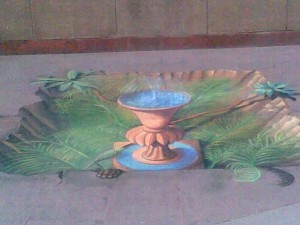
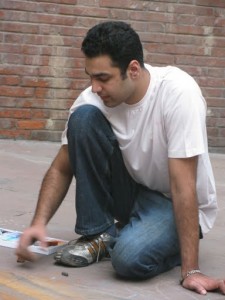
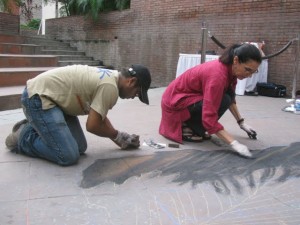
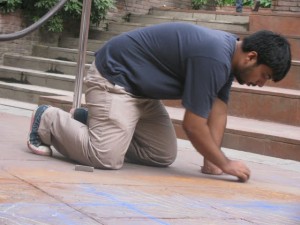
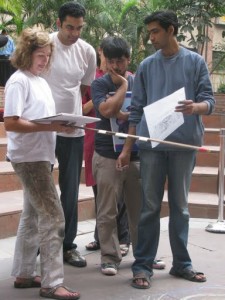
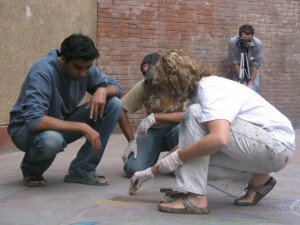
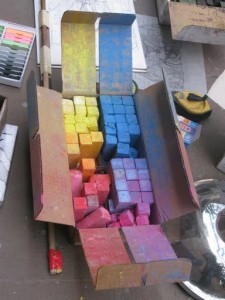
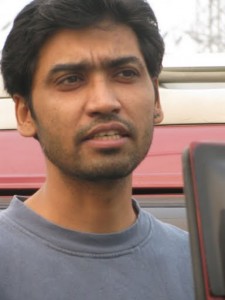
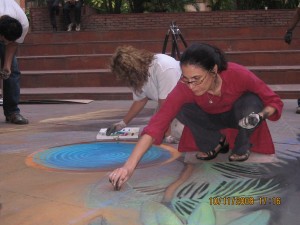
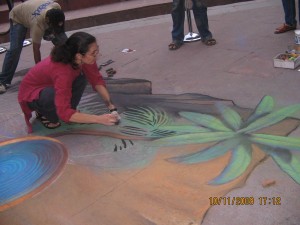
Chennai
After traveling to Chennai in the Indian state of Tamil Nadu on the second city stop, my itinerary changed somewhat due to impending bad weather. I was scheduled to conduct workshops at the Stella Maris College of Art but due to monsoon season, working outside was not going to be possible. Instead of using chalk on pavement, we would switch over to paint on panels in creating mural paintings for the exterior of wall of the school. Our themes were to be Global Warming, Environmental Awareness and Polution. Initiated by local artist, Jacob Jebaraj, from the Cholomandal Artist Community just south of Chennai, I had the pleasure of working with students from both Stella Maris and the Government College of Art in Chennai. After 2 days of working on and completing our panels, the weather let up a bit and I decided for day 3 I was going to bring my chalk pastels for a demo, outside on the wet pavement. It showered off and on most of the day but fortunately the Gods were with me and I was able to find a small patch of dry asphalt to work up some 3D demo images. The students were very keen on seeing a 3D image and were eager for me to get started.
After the demo, I had the students work on some traditional street painting images that allowed for them to understand what its like to apply chalk to asphalt. Their enthusiasm went pretty far in creating some interesting works until the monsoon storms started up again and all the images were washed away in a matter of minutes! C’est la vie – weather is a factor with this art form and it really becomes a crash course in learning how to let go of your work!
Thanks again to everyone at the American Center, US Consulate, Chennai : APAO Ragini Gupta, Program manager Usha P. Davalu and Mr. Ravi Srivastava, Vice – Consul. Thanks also to Jacob Jebaraj, Ms. Alamelu, Mr. Devanathan and everyone at the Stella Maris College.
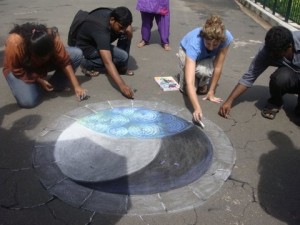
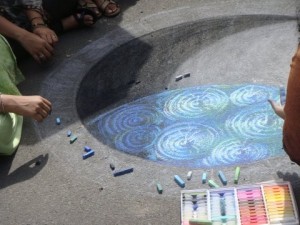
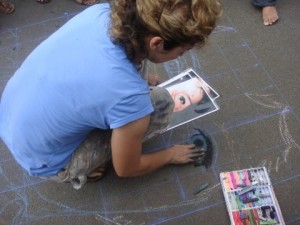
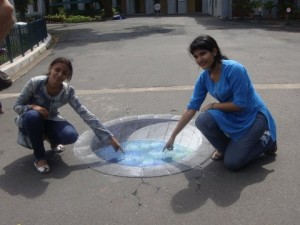
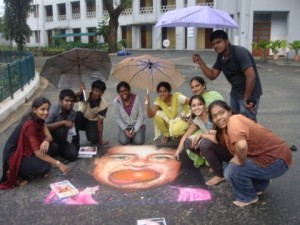
Hyderabad
What a lovely city Hyderabad is! I arrived there after the rains of Chennai to a garden city perched on a series of hills situated on a plateau in the Indian state of Andhra Pradesh. I was scheduled to begin working the next day at the University of Hyderabad, which is home to the distinguished graduate school of Fine Arts. Salil and Juliet were my liaisons from the American Center. Arriving at the University we were informed that there was a strong possibility of rain during the workshop program as well! The University was in the midst of exams and announcements for the workshop had gone out with no great expectations of a large turnout. As it turned out, 3D street painting was a very popular topic amongst the art students on campus and the first day opened with an overwhelming number of student participants.
I was scheduled to create a large 3D image to begin the program, which is what I did. I used an existing staircase leading up to the Fine Art auditorium building as my point of departure. There was ample space to work so I designed a piece that would visually continue receding into the pavement, using the stairs as the central focus for the image. Just about 4 or 5 hours into the painting we were rained out – literally. I sat on the stairs as I watched my painting, which had been created with student volunteers, slide down the pavement in a river of water. That was disappointing but something you just have to get used to if you want to become a serious street painter. I felt frustrated for the workshop students as they had begun a number of paintings in the adjoining areas – some almost complete – only to see their efforts disappear before their eyes. They asked me how to save the paintings but there was just no way to do that given the sudden appearance of the downpour. It was a tough break for them – no one wants to experience a wash out with their first painting out – but they did show resilience by returning the next day for another round of chalk experimentation.
Because of the continued weather restrictions, I wound up creating a 3 hour painting under a carport at the dean’s administration offices. The composition I decided on would show an illusion of space that receded into the pavement as a means to show the students how to work out believable architectural forms through proper lighting. Earlier in the day I had worked up a quick 30 minute demo for the students on a covered courtyard outside of their painting and ceramics studios. I had a nice sized crowd observing during the process, intently focused on how this kind of image works. It felt oddly like a film premier as camera phones were pulled out and began clicking left and right – street painting paparazzi! These students were fascinated at how the image worked but more importantly, how they would look interacting with the painting. It was a lot of fun for everyone who participated. With some basic rules and principles illustrated, these enthusiastic and talented students got the hang of it and seemed to be ready to work out some of their own images when the weather cleared up.
Before we departed U of H, we met with Professor Vinod Pavarala, who graciously hosted lunch, and Mr. Sham Sunder, who was kind enough to show us around the Fine Arts Department where I was pleased to discover a trompe l’oeil style wall mural and an anamorphic image of an arm coming out of the pavement that the students had created several years back with paint on pavement. Sham also escorted us to the site of the new Fine Arts Department buildings, which were under construction and scheduled to open in the coming year, and graciously shared their vision of a new and improved Fine Arts facility. It was all very impressive indeed.
Sincerest thanks to the remarkable US Consulate team: Juliet Wurr, Salil Kader, Rachel Vandana, and everyone from the American Center, US Consulate – Hyderabad for an outstanding job and assistance. Special thanks to Professor Vinod Pavarala , Dean – Sarojini Naidu School of Performing Arts, Fine Arts & Communication and Mr. R. S. Sham Sunder – Department Head, Fine Arts; University of Hyderabad.
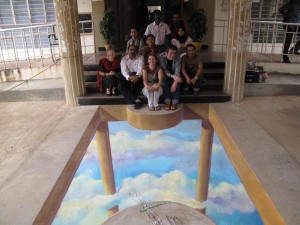
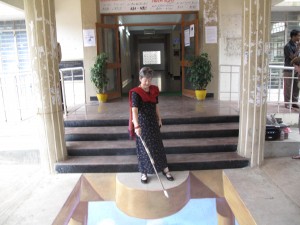
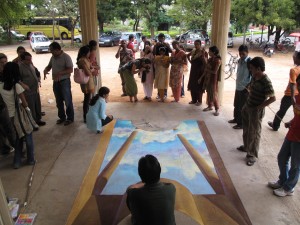
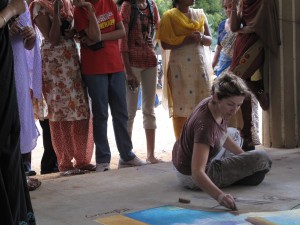
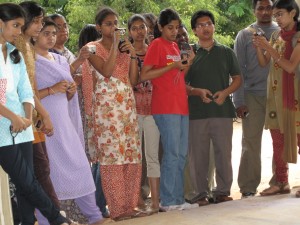
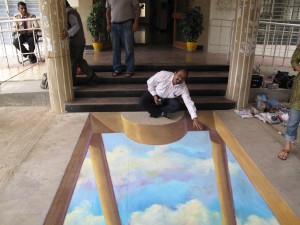
Kolkata
Final stop on the tour: Kolkata. What a city! In my mind India is a country comprised of contrasts & Kolkata is the undisputed capital of this phenomenon. Arriving I was struck with how packed this place was – right out of the airport you proceed to downtown through poverty ridden areas, crowded neighborhoods laced with traffic whizzing by in a constant stream of color and noise. Upon nearing the city center I couldn’t help but think of the film Bladerunner – city streets of congestion and chaos, trapped by buildings with painted features smeared and decaying to reveal the worn ugliness underneath. Kolkata is an old city – having been established by the British Empire early in it’s quest for domination over the lucrative trade routes that had been established in the area. History 101 facts: Kolkata began with a village called Kalikata (Land of Kali, a Hindu goddess), formally recognized in 1690 by the English East India Company. Don’t get me wrong – Kolkata is a place you want to see. Just be prepared for the assault on the senses when you arrive.
In direct contrast to the city’s visual degradation, the campus of the Government School of Art, where I was to work for the coming 3 days, proved to be an oasis of beauty and serenity. Located on the busy Jawharlal Nehru Rd., the campus was a majestic old estate survived from days of the British Empire, tucked away behind a discreet barricade. Upon arrival we were escorted into the inner courtyard, where I was delighted to find a modest garden which welcomed each of us to come sit peacefully, forgetting the frenetic energy outside the gates. This is where I met the gracious Dipali Bhattacharya, our official hostess, renowned painter and officer-in-charge of the workshop, who kindly made me feel welcome to the school. I also met Mr. Pramathesh Chandra, Head of the Painting Department, a soft spoken gentleman whom I liked immediately, on hand to assist with our program. I could tell he was well liked and admired by all the students. The American Center folks and school officials had arranged for a welcoming ceremony in my honor and I was very touched to see an announcement banner the students had created as a part of the event.
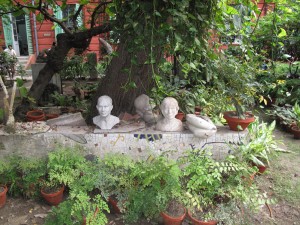
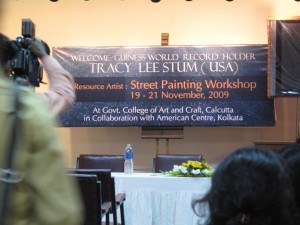
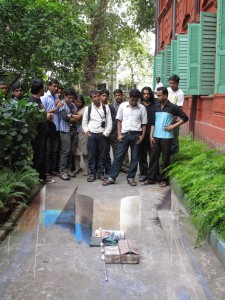
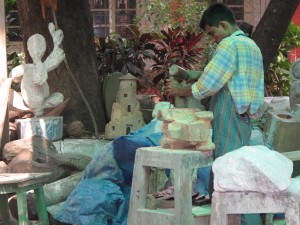
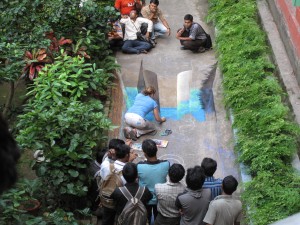

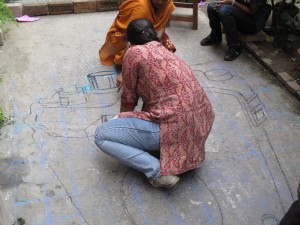
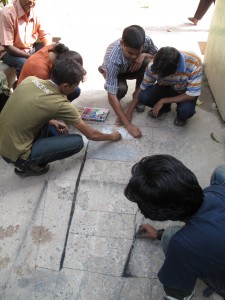
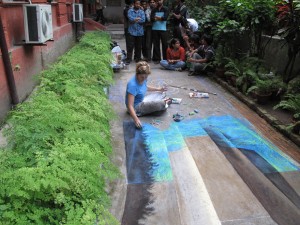
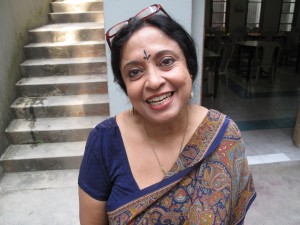
After some media interviews I proceeded to assess the campus for appropriate street painting sites. I was scheduled to create a painting of my own as the workshop’s primary objective. In addition I had to locate some adequate surfaces for the students to make their images on and was hoping for some place that would accommodate both needs. I found a small walkway that looked good, although covered with moss and bird droppings. Dipali wasn’t too sure this was the best choice but I insisted – after some initial cleaning I knew it would be just fine. Plus I liked the existing architectural elements that defined the space. Something to play with when coming up with a decent composition. I like a good challenge – especially when I’ve got chalk on the brain.
Once we had the working area sorted out I got right to work. I decided that I would create an image that could integrate with the surroundings – using the restrictions and the environment to inform me as to how to proceed. The idea of a pool drawn on the pavement about 1/2 way down the walkway seemed sensible and interesting to me – something that could be viewed and interacted with on either end. I’d use the existing pavement color as architecture and try to achieve a seamless quality to the image. Once I determined the size of the image and what components I hoped to add I just started drawing. The composition wasn’t set in stone and not fully realized, which allowed me to work organically – just creating as I went along, while paying attention to the intuitive impulses I was receiving. That’s my favorite way to work. I’m fairly confident in my own abilities and understanding of how 3D pieces work so I really enjoy ‘going with the flow’ while I create. I find that the impulses I get while working are often the best solutions – not being locked in to a design or preconceived image is very liberating. You never know what’s going to happen and I love the mystery!
As I was working I was explaining my processes to the students. The students at the Government College proved to be not only talented, but enthusiastic, engaging and adept at comprehending the intentions and concepts behind the work. They could not wait to get started on their own images, so with a little guidance they began on several satellite works around the campus. One group of students began working on a 3D image of a camera that I had prepared for them while the others experimented with descending stairs, wells and a free standing chair in anamorphic perspective – all outstanding. This created the vibe that a mini street painting festival was ‘happening’ on the campus over the 3 days and the excitement and participation mounted. Apparently most of these students had not previously worked in a collective manner, in groups, on a common art project, which is nothing new in art schools around the world. This was a new experience for them and they ate it up. The camaraderie they built and shared proved to be a bonding experience for them and touched my heart. The responses I received from students who participated epitomized enthusiasm and genuine interest. I think this is what I love most about street painting – artists can connect with each other, with their viewers and with themselves, in an enjoyable yet challenging manner.
I was sad to leave the students and faculty at the Government College who shared so much of themselves with us. I didn’t get to see any of the city, but what difference does that make? I did get a chance to feel the city through it’s people, and that will stay with me forever. That being said, I expect to see many more works of street art popping up in Kolkata and India at large. This art form isn’t going away – in fact, it’s sweeping the globe!
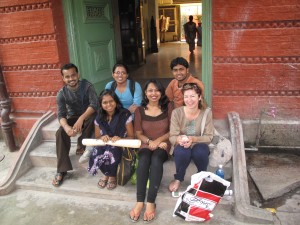
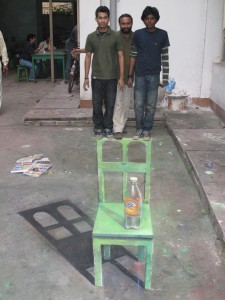
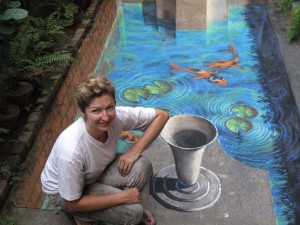
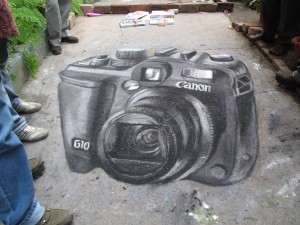
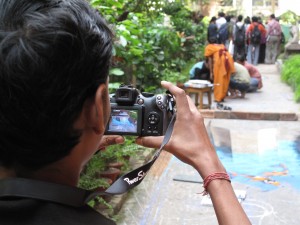
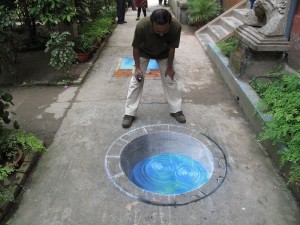
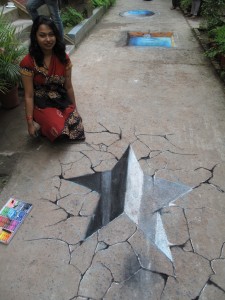
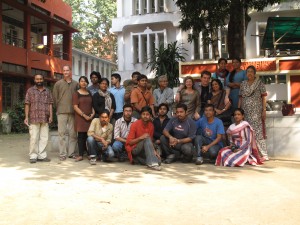
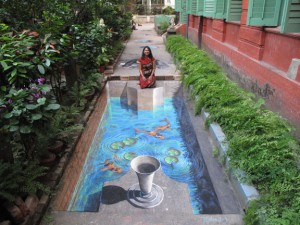
Thanks to everyone at the American Center, US Consulate, Kolkata: APAO Moulik D. Berkana, Program manager Smita Basu. Thanks with sincere gratitude to Dipali Bhattacharya, Pramathesh Chandra and all the students at the Government College of Art and Craft.








Wow Tracy what an adventure. The work is outstandingAs usual. You just get better!
tanza
Thanks so much Tanza – coming from you that’s a big compliment! It’s a two way street as you are such an inspiration to me!
wonderful!!!!!!!!!!!!!!!!!!!!!!!!
your works are really great tracy….i missed a chance to work with u in stella maris college:(…feel really bad…plz do inform me if u are back …luv u n ur works tracy…
send mi all heads of department in your university , just now that your art is good and am in love with your colors the rhythm is so good, they really communicate some thing